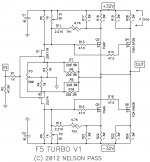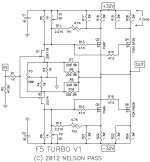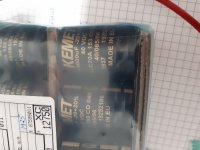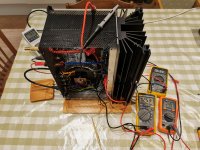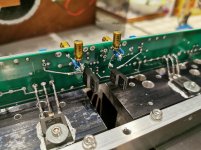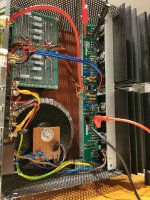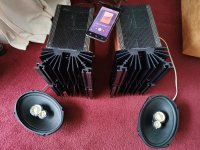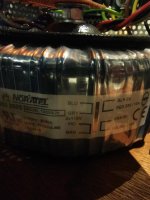to nikwatt #6360
Hello Nicola,
you use a 600 VA toroid with secondaries of 2x25V~.
After the bridgerectifier and capbank you will 'land' anywhere around +-32,5 V?
(25 V ~ x 1,3 = 32,5V - rule of thumb/ could be a bit higher?).
The voltage rating at 35V of your caps (15000uF / 35V) seems a bit low for me.
Not a lot of headroom! In other words - close to none. I would have used 50V
types minmum to have a safety margin.
Greets
Dirk
Hello Nicola,
you use a 600 VA toroid with secondaries of 2x25V~.
After the bridgerectifier and capbank you will 'land' anywhere around +-32,5 V?
(25 V ~ x 1,3 = 32,5V - rule of thumb/ could be a bit higher?).
The voltage rating at 35V of your caps (15000uF / 35V) seems a bit low for me.
Not a lot of headroom! In other words - close to none. I would have used 50V
types minmum to have a safety margin.
Greets
Dirk
When I'm using the cascode voltage formula to determine desired resistance values for R25-28, what cascode voltage am I actually shooting for in my F5Tv2 build? Maybe shooting for just under 24V? Using the lowest suggested value of 4.75 across the board I get 16V of cascode voltage. Is that where I want to be or should I look at possibly dropping the resistance of R25,26? Or perhaps I'm misunderstanding something?
Thanks again!
Thanks again!
Most people seem to aim at between 11 and 16 volts. I don’t think it is super critical. You are lowering the voltage on the input Jfets to a safe level and also reducing the power consumption, so the jfets run cooler.
Just make the cascode resistors all the same so your cascode voltage is approx 1/2 the rails.
4.75 across the board for 16V on the nose it is then.
Are y'all sick of hearing me say "thanks again" yet? I hope not, I still have a few more parts to source before I start building
Seriously, I hugely appreciate your help.
So I've finally got to biasing my F5T V2. Made a couple of mistakes, but managed to spot them before the smoke showed me where they were. Just waiting for the second mono block to get up to temperature and thought I should share some pictures.
I' m starting my bias at 0.25V (like Nelson did on his V1 build) which give a max heatsink temp of 42C (on the first mono block) and output offset seems stable under 2mV and 80W power consumption at the mains input. Rails ar at 36V. Cascaded with10k resistors to get 17V across the JFETs.
Like so many others, I send a massive thank you to Nelson for sharing this design and all the other contributers that have explained it clearly enough for even me to follow.
I' m starting my bias at 0.25V (like Nelson did on his V1 build) which give a max heatsink temp of 42C (on the first mono block) and output offset seems stable under 2mV and 80W power consumption at the mains input. Rails ar at 36V. Cascaded with10k resistors to get 17V across the JFETs.
Like so many others, I send a massive thank you to Nelson for sharing this design and all the other contributers that have explained it clearly enough for even me to follow.
Attachments
And they play music. That's a relief! Silent when the music is stopped. But they do have some mechanical transformer hum. Which is probably to be expected with 230V transformers (cheap mistake purchase) and a mains supply of 243V today.
Any suggestions?
Any suggestions?
Attachments
Thanks for the compliment. I certainly know more than when I started, thanks in large to this forum.
The speaker output is very quiet and free of hum. The hum noise is generated by the transformer vibration and is present when no speakers are attached. I guess I should try some sort of DC blocker on the mains? Can anyone recommend a particular design or alternative solution?
The speaker output is very quiet and free of hum. The hum noise is generated by the transformer vibration and is present when no speakers are attached. I guess I should try some sort of DC blocker on the mains? Can anyone recommend a particular design or alternative solution?
Attachments
Shteve: I have chased down hum myself lately, it is fun, but also tiring.
Firstly: It looks like a fine build. You know your stuff. So I will ask you first of all: how many caps and what values do use, and what is the R in your CRC?
Regards,
Andreas
Sorry Andrea's, I didn't answer your question. There are 8 x 15kuF caps for each mono block. So that's 30kuF then 4x 0.47ohm resistors and then another 30KuF for positive and the same for negative rail supply.
Best regards
Steve
Ok, so no hum in the speakers is very good. I had some, but all but removed it now. A learning experience, for sure.
So, as far as I can see, you have more R (0R117 vs spec at 0R067) than spec for the PSU. That means you can possibly add three more Rs to each rail and thus reduce losses even more. You might run the risk of getting some more ripple affecting the sound at high output, but that is up to you to decide.
Wrt mechanical hum, Noratels are known for this. I have one too. It rings and it hums. Today I put a thicker rubber pad under it, and in fact it now hums less (mechanical, not in speakers). I have an engineer friend who always puts them in a metal box with damping material inside. I have not done this, so can not tell you how to proceed.
Wrt ringing noise, I found that less line noise gives less audible noise directly from the transformer. A sensitive thing, it might seem.
I think as long as there is no hum in the speakers, you did a good job!
Good luck!
So, as far as I can see, you have more R (0R117 vs spec at 0R067) than spec for the PSU. That means you can possibly add three more Rs to each rail and thus reduce losses even more. You might run the risk of getting some more ripple affecting the sound at high output, but that is up to you to decide.
Wrt mechanical hum, Noratels are known for this. I have one too. It rings and it hums. Today I put a thicker rubber pad under it, and in fact it now hums less (mechanical, not in speakers). I have an engineer friend who always puts them in a metal box with damping material inside. I have not done this, so can not tell you how to proceed.
Wrt ringing noise, I found that less line noise gives less audible noise directly from the transformer. A sensitive thing, it might seem.
I think as long as there is no hum in the speakers, you did a good job!
Good luck!
I tried replacing the foam either side of the transformer with thicker and more dense foam. The mechanical hum 'might' be quieter, but I can still hear it from the listening seat 4m away. Not a supprise as the outside and inside of the transformer are still free to flap about, but the right place to start.
Looks like I need to try DC blocker, potting the transformer or adding coils to the primary (which doesn't make sense to me yet. I thought one would want to remove coils to reduce saturation, but I read it on the Internet so it must be true...?) or another solution that doesn't involve buying new transformers.
Looks like I need to try DC blocker, potting the transformer or adding coils to the primary (which doesn't make sense to me yet. I thought one would want to remove coils to reduce saturation, but I read it on the Internet so it must be true...?) or another solution that doesn't involve buying new transformers.
I have this hum problem with 800va toroids in my F5t3 monoblocks. One transformer is worse than the other. If you add turns to the primary you are effectively reducing the primary voltage on the transformer which decreases the chance of saturation and mechanical buzzing.
A DC blocker will help in a lot of cases. I use one on my setup and it made a difference.
A DC blocker will help in a lot of cases. I use one on my setup and it made a difference.
I tried replacing the foam either side of the transformer with thicker and more dense foam. The mechanical hum 'might' be quieter, but I can still hear it from the listening seat 4m away. Not a supprise as the outside and inside of the transformer are still free to flap about, but the right place to start.
Looks like I need to try DC blocker, potting the transformer or adding coils to the primary (which doesn't make sense to me yet. I thought one would want to remove coils to reduce saturation, but I read it on the Internet so it must be true...?) or another solution that doesn't involve buying new transformers.
I would say that if a transformerof that size hums so loud it can be heard 4 meters away, something might be wrong with it. Or there is something fishy going on in your electrical circuits. It might be normal, but I have never heard that loud mechanical hum.
In comparison, on my Noratel 600va, I need to put my ear against the chassis to hear anything.
Have you tried:
1: connecting the amp to a different circuit in your home, preferably one with little to no SMPSes, microwaves, dishwashers, AC, fans, dimmers or ELECTRICAL CARS connected to it? Is there ANY change at all?
2: Is there any change between day and night, morning and afternoon?
3: is there any change if you disconnect everything else on the circuit?
If the answer is yes to these questions, the DC blocker route should be worth a go.
Remember, the problem can be caused also by neighbours use of the grid.
PS: triple checking secondary and primary connections might prove fruitful too.
Hope you solve it!
Regards,
Andreas
- Home
- Amplifiers
- Pass Labs
- F5 Turbo Builders Thread
